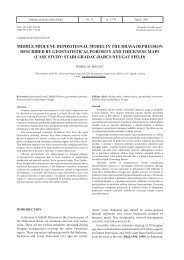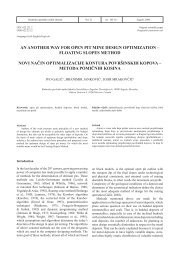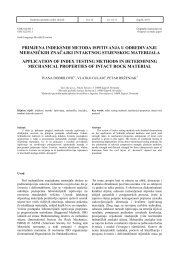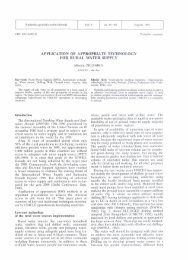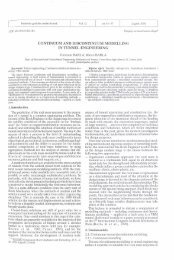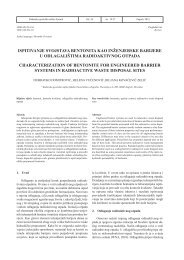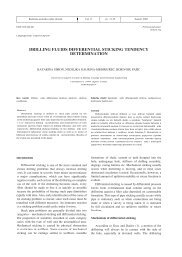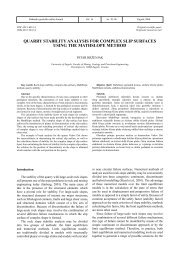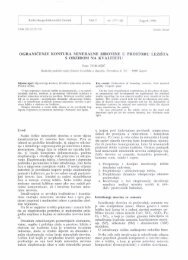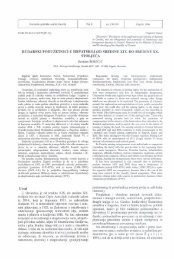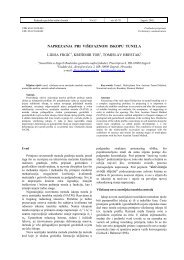primjena petrofizikalnih podataka za ocjenu nepropusnosti ...
primjena petrofizikalnih podataka za ocjenu nepropusnosti ...
primjena petrofizikalnih podataka za ocjenu nepropusnosti ...
Create successful ePaper yourself
Turn your PDF publications into a flip-book with our unique Google optimized e-Paper software.
132<br />
Rud.-geol.-naft. zb., Vol. 24, 2012.<br />
D. Vulin, L. Perić, T. Kurevija: Primjena <strong>petrofizikalnih</strong> <strong>podataka</strong> <strong>za</strong> <strong>ocjenu</strong>...<br />
16. Levanat, I. (1997): Radioaktivni otpad. Agencija <strong>za</strong> posebni otpad<br />
Zagreb, Zagreb<br />
17. Leverett, M. C. (1941): Capillary Behaviour in Porous Solids,<br />
Trans. AIME, Vol. 142, str. 152-169<br />
18. Lock, G.A. and Hoyer, W.A., (1971): Natural gamma-ray spectral<br />
logging. The Log Analyst, 12:3-9.<br />
19. Nolvi L. (2009): Manufacture of Disposal Canisters, Posiva Oy,<br />
Finland<br />
20. Nowvak T. J., Lester G. W. (1955): Analysis of pressure fall-off curves<br />
obtained in water injection wells to determine injective capacity<br />
and formation damage. Journal of Petroleum Technology, Vol. 204,<br />
p.p. 96-102.<br />
21. Pirson, S.J. (1958): Oil Reservoir Engineering, McGraw Hill 2nd<br />
Ed, NYC, p137-302 Ri<br />
22. Pritrsky i dr. (2006.): Assessment of Gas Producing Radioactive<br />
Waste Disposal, Journal of Electrical Engineering, Vol. 57, NO. 4,<br />
2006, 235–237<br />
23. Purcell, W. R. (1949): Capillary Pressures - Their Measurement<br />
Using Mercury and the Calculation of Permeability Therefrom,<br />
Trans. AIME, Littleton, USA, Vol. 186, str. 39-48<br />
24. Scheidegger, A., E., (1960):The physics of flow through porous media,<br />
New York, Macmillan, 1960.<br />
25. Schweitzer, J.S,. (1991): Nuclear techniques in the oil industry,<br />
Nuclear Geophysics, 5:65-90<br />
26. Serra, O., J. Baldwin and J. Quirein, (1980): Theory, interpretation<br />
and practical applications of natural gamma-ray spectroscopy.<br />
SPWLA 21 st Ann. Log.Sympos, paper Q.<br />
27. Swift N.P. i dr., (2009): Deep Borehole Disposal of High-Level Radioactive<br />
Waste. Sandia Report, SAND2009-4401.<br />
28. Van Geet, M. i dr., (2007): Efficiency of a borehole seal by means of<br />
pre-compacted bentonite blocks Original Research Article Physics<br />
and Chemistry of the Earth, Parts A/B/C, Volume 32, Issues 1–7,<br />
123-134<br />
29. Volckaert G.L. i dr. (1997): MEGAS: modelling and experiments on<br />
gas migration in repository host rocks, European Comission Final<br />
Report - Phase 1, EUR 17453 EN, 1997.<br />
30. Wahl, J.S., (1983): Gamma-ray logging. Geophysics, 48(11):1536-<br />
1550.<br />
31. Welge, H. J., (1949): Displacement of Oil from Porous Media by<br />
Water or Gas, Trans. AIME, 179, 133<br />
32. Welge, H. J., (1952):A Simplified Method for Computing Oil Recovery<br />
by Gas or Water Drive, Petroleum Transactions, AIME, Volume<br />
195, 1952, 91-98<br />
33. Worthington, P.F. i dr., (1990): Sediment cyclicity from well logs.<br />
In:Hurst, A. et al. (eds.), Geological applications of wireline logs.<br />
Geol. Soc. of London, Spec. Publ. 48, 123-132.<br />
34. Yale, DP, (1993): Nabor, GW, Russell, JA. Application of Variable<br />
Formation Compressibility for Improved Reservoir Analysis. SPE<br />
68th Annual Technical Conference and Exhibition, Houston, Texas<br />
THE USE OF PETROPHYSICAL DATA FOR THE<br />
PERMEABILITY ASSESSMENT OF AN UNDER-<br />
GROUND NUCLEAR WASTE REPOSITORY<br />
Nuclear waste repositories should be designed in order<br />
to mantain the waste for several thousand years. The<br />
main petrophysical properties that should be observed for<br />
such repositories are properties that are related to fluid<br />
migration, i.e. brine-gas relative permeability, injectivity<br />
and change sin fluid saturation due to capillary pressure.<br />
Gases that have to be taken into account are products of<br />
anaerobic metal corrosion of tanks (iron and aluminium),<br />
and radiolysis of matrix and water. Products of corosion<br />
are usually hydrogen, methane and carbon dioxide, and<br />
products of radiloysis are 14 CH 4<br />
i 14 CO 2.<br />
Although the waste<br />
is stored in tanks that can persist the most extreme conditions,<br />
it is necessary to ensure that gases that can come<br />
into existence nearby the storage tank will not spread far<br />
from the repository well. Technology that was developed<br />
by petroleum exploration and production industry is at<br />
sofisticated enough to determine all geological and petrophysical<br />
aspects of the waste disposal. The main task<br />
is to determine if there is possibility of leakage pathways<br />
in the repository rock. In this work are described the most<br />
common methods for determining flow properties of the<br />
rock: grain granulation, porosity, and absolute permeability.<br />
It was described how the gas permeability measured<br />
with nitrogen can be corrected for Klinkenberg-effect in<br />
order to obtain absolute permeability. Then utilisation of<br />
several special core analyses was proposed - the main<br />
interrelationships between mechanical rock properties,<br />
i.e. pore compressibility and porosity, and consequently<br />
permeability. Furthermore, there was explained importance<br />
of capillary pressure curves and its correlation with<br />
curves of relative permeabilities. Relative permeabilities<br />
curves can describe possibility of gas products migration<br />
through the brine saturated rock. Also, it was necessary to<br />
point out the phenomena of saturation curve hysteresis,<br />
which leads to different relative permeability curves depending<br />
on two possible directions of saturation process<br />
– imbibition and drainage.<br />
Petrophysical measurements give data required for<br />
well-log calibration and input data for reservoir flow calculations<br />
and simulations.<br />
For a nuclear waste disposal site, the most common<br />
method for predicting injectivity that was found in literature<br />
is fall-off test. Main parameters that are involved in<br />
pressure decline curve analysis are described. Injectivity<br />
in the case of nuclear waste disposal is tested because of<br />
possible danger due to pressure incerease because of gaseous<br />
products generation.<br />
Well testing of pressure changes can give validation of<br />
lab data, and can be used in order to correct input data for<br />
flow calculations. Because of semi-empirical nature of the<br />
measured data interpretation, some testing and calculation<br />
methods should be slightly modified for nuclear waste re-



